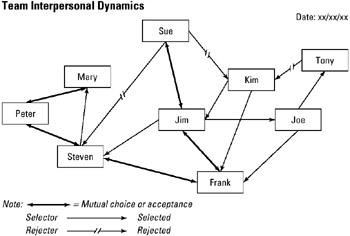Tool 182: Sociogram
| AKA | Interaction Diagram, Sociometric Diagram |
| Classification | Team Building (TB) |
Tool description
The sociogram is an interaction diagram that illustrates intrateam communication patterns, interpersonal dynamics, and compatibility among team participants. Introduced by J. L. Moreno in 1934, the sociogram is helpful in promoting partnerships, team cohesiveness, and mutual acceptance; it therefore allows more participation and openness in teams.
Typical application
-
To diagram a team's interpersonal relationships and cooperation.
-
To obtain an understanding of intrateam interactions and acceptance of team participants.
Problem-solving phase
| Select and define problem or opportunity | |
| → | Identify and analyze causes or potential change |
| → | Develop and plan possible solutions or change |
| Implement and evaluate solution or change | |
| Measure and report solution or change results | |
| Recognize and reward team efforts |
Typically used by
| Research/statistics | |
| Creativity/innovation | |
| Engineering | |
| Project management | |
| Manufacturing | |
| Marketing/sales | |
| Administration/documentation | |
| 3 | Servicing/support |
| 2 | Customer/quality metrics |
| 1 | Change management |
before
-
Demographic Analysis
-
Circles of Influence
-
Audience Analysis
-
Organization Mapping
-
Observation
after
-
Critical Dialogue
-
Relationship Map
-
Rotating Roles
-
Pair Matching Overlay
-
Resource Histogram
Notes and key points
-
Sociogram legend:

-
A variation of showing interactions is to draw the number of choices (mentions) given or received:

-
Limit to 10 the number of people in a sociogram.
Step-by-step procedure
-
STEP 1 Periodically, the team facilitator, coach, or a designated team participant performs observations of team behavior and interpersonal communications.
-
STEP 2 Notes on communication patterns, acceptance, and rejection, "who interacts with whom" (Moreno), and amount of participation are collected.
-
STEP 3 Next, a sociogram is drawn and shared with the team. An open discussion follows on ways to improve the team's performance.
-
STEP 4 A list of possible improvements is developed.
Example of tool application

EAN: 2147483647
Pages: 326